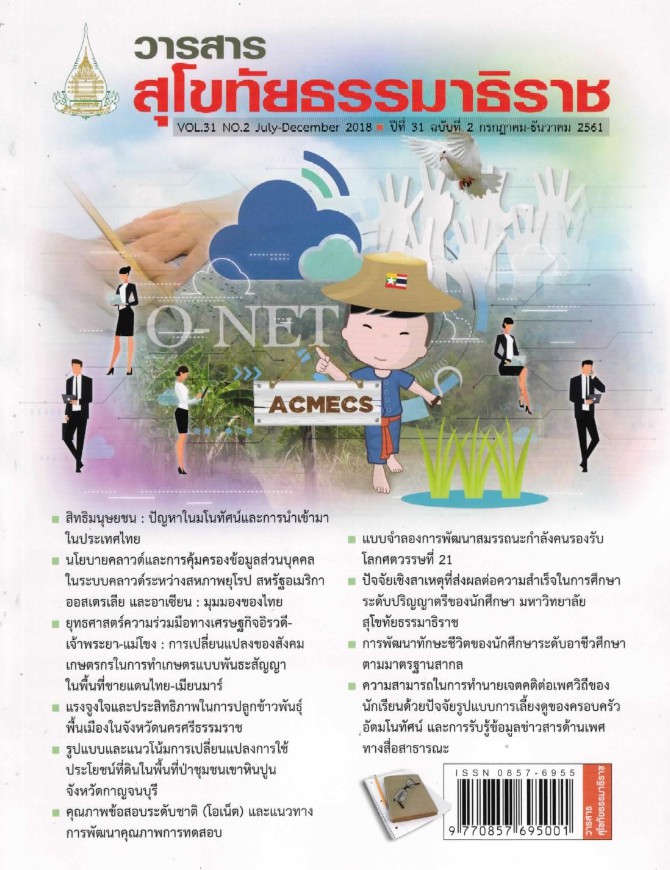แรงจูงใจและประสิทธิภาพในการ ปลูกข้าวพันธุ์พื้นเมืองในจังหวัด นครศรีธรรมราช
คำสำคัญ:
ประสิทธิภาพการผลิตข้าวพันธุ์พื้นเมือง, ปัจจัยที่ส่งผลต่อประสิทธิภาพ, นครศรีธรรมราชบทคัดย่อ
งานวิจัยนี้มีวัตถุประสงค์เพื่อ 1) วิเคราะห์ปัจจัยที่ส่งผลต่อการตัดสินใจปลูกข้าวพันธุ์พื้นเมือง และ 2) วิเคราะห์ประสิทธิภาพทางเทคนิคในการผลิตข้าวพันธุ์พื้นเมืองในพื้นที่ตำบลบ้านเพิง ตำบลท่าพญา ตำบล ขนาบนาก และตำบลปากแพรก อำเภอปากพนัง จังหวัดนครศรีธรรมราชในช่วงปีการเพาะปลูก 2558/2559 เป็นการวิจัยแบบผสมวิธีประกอบด้วย การสัมภาษณ์เชิงลึกกลุ่มตัวอย่างจำนวน 14 คน การประชุมกลุ่มย่อย 2 ครั้ง และการวิเคราะห์เชิงปริมาณจากกลุ่มตัวอย่างจำนวน 185 ครัวเรือน วิเคราะห์ปัจจัยที่ส่งผลต่อการ ตัดสินใจปลูก และใช้แบบจำลองการผลิตแบบ สโตคาสติก โปรดักชันฟรอนเทียร์ ในการวิเคราะห์ประสิทธิภาพ การผลิตข้าวพันธุ์พื้นเมืองของตัวอย่างแปลงนาจำนวน 206 แปลง ผลการวิเคราะห์พบว่า 1) การตัดสินใจปลูกข้าวพันธุ์พื้นเมืองถูกกำหนดจากปัจจัยที่สำคัญคือ (1) ความคาดหวังที่จะได้รับผลผลิตข้าวเพื่อบริโภคในครัวเรือนและกำไรจากการผลิต (2) ทรัพย์สินหรือต้นทุน ที่ครัวเรือนมี ได้แก่ ทรัพยากรธรรมชาติ (ปริมาณน้ำ ลักษณะภูมิประเทศ) ทรัพยากรมนุษย์ (แรงงานครัวเรือน และ ความรู้ทักษะ) กรรมสิทธิ์ที่ดิน เงินออมเพื่อการลงทุน และเครือข่ายและการสื่อสารระหว่างครัวเรือน (3) ความเสี่ยงและแนวโน้มที่ครัวเรือนเผชิญ ได้แก่ ศัตรูพืช และแนวโน้มราคาข้าว และ (4) โครงสร้างพื้นฐาน ซึ่ง ประกอบด้วย การคมนาคม และระบบชลประทาน จากการวิเคราะห์ประสิทธิภาพการผลิตพบว่า กลุ่มตัวอย่าง ส่วนใหญ่มีประสิทธิภาพทางเทคนิคของการผลิตอยู่ในระดับต่ำ และ 2) ความด้อยประสิทธิภาพในการปลูกข้าว พันธุ์พื้นเมืองชี้ให้เห็นว่า ปัจจัยที่ทำให้ประสิทธิภาพการผลิตอยู่ในระดับต่ำประกอบด้วย (1) ลักษณะของ ครัวเรือน ได้แก่ หัวหน้าครัวเรือนมีอายุน้อย ระดับการศึกษาที่ต่ำ และมีแรงงานด้านการเกษตรจำนวนน้อยและ (2) การขาดแรงจูงใจในการปลูกข้าวพันธุ์พื้นเมืองเชิงพาณิชย์ (ครัวเรือนที่มีพื้นที่เช่าเพื่อทำการเกษตร จำนวนน้อยและมีพื้นที่ปลูกข้าวพันธุ์พื้นเมืองจำนวนมาก)
เอกสารอ้างอิง
Berger, T. (2001). Agent-Based Spatial Models Applied to Agriculture: A Simulation Tool for Technology Diffusion, Resource use Changes and Policy Analysis. Agricultural Economics, 25 (2–3), 245-260. doi: http://dx.doi.org/10.1016/S0169-5150(01)00082-2.
DFID. (1999). Sustainable Livelihoods Guidance Sheets. London: Department for International Development. Available at: http://www.ennonline.net/resources/667 (Accessed: 30 January 2014).
Encheva, S. (2010). Ordinal representation of ranking. Paper presented at the Proceedings of the 12th WSEAS international conference on Mathematical methods, computational techniques and intelligent systems, Sousse, Tunisia.
Goyal, S., Suhag, K. S., & Pandey, U. K. (2006). An Estimation of Technical Efficiency of Paddy Farmers in Haryana State of India. Indian Journal of Agricultural Economics, 61(1), 108-122.
Jensen, R. E. (1986). Comparison of Consensus Methods for Priority Ranking Problems. Decision Sciences, 17(2), 195-211. doi: 10.1111/j.1540-5915.1986.tb00221.x.
Jitpakdee, R., & Wongsawat, S. (2016). The Participation of Rice Farmer at Pakpanang Basin in Maintaining Identity of Native Rice. Area Based Development Research, 8(2), 56-75. (in Thai)
Kea, S., Li, H., & Pich, L. (2016). Technical Efficiency and Its Determinants of Rice Production in Cambodia. Economies, 4(4), 1-17.
KOFC. (2012). Future Directions of Rice Policy Reform. Bangkok: Kasetsart University-Office of Agricultural Economics Foresight Center. Available at: http://www.oae.go.th/ewt_news.php?nid=13737&filename=news (Accessed: 1 June 2017).
Kongrithi, W., & Petcharat, S. (2013). Dynamics of Rice Economic in Southern Thailand. Bangkok: The Thailand Research Fund. (in Thai)
Ndayambaje, J. D., Heijman, W. J. M., & Mohren, G. M. J. (2012). Household Determinants of Tree Planting on Farms in Rural Rwanda. Small-scale Forestry, 11(4), 477-508. doi:10.1007/s11842-012-9196-0.
Nualnoom, P. (2018). An Application of the Analytical Hierarchy Process (AHP) in Analyzing Factors Influencing Decision-making on Local Paddy Rice Cultivation: Case Study of Khanabnak sub district, Pak Phanang District, Nakhon Si Thammarat province. WMS
Journal of Management, 7 (Special issue), 27-42.
Nualnoom, P., Wehrmeyer, W., & Morse, S. (2016). Analysing household decision-making on oil palm cultivation in Thailand. Journal of Land Use Science, 11(5), 560-578. doi:10.1080/1747423X.2016.1204019.
OAE. (2013). Opportunity to Thai Agricultural Products to the ASEAN Community. Bangkok: Office of Agricultural Economics. Available at: http://moac2aec.moac.go.th/download/AC/agriculture%20Thai.pdf (Accessed: 10 June 2015).
Omondi, S. O., & Shikuku, K. M. (2013). An Analysis of Technical Efficiency of Rice Farmers in Ahero Irrigation Scheme, Kenya. Journal of Economics and Sustainable Development, 4(10), 1–12.
Patel, S. H., Pinckney, T. C., & Jaeger, W. K. (1995). Smallholder Wood Production and Population Pressure in East Africa: Evidence of an Environmental Kuznets Curve? Land Economics, 71(4), 516-530.
Rasul, G., & Thapa, G. B. (2003). Shifting Cultivation in the Mountains of South and Southeast Asia: Regional Patterns and Factors Influencing the Change. Land Degradation and Development, 14(5), 495-508.
Saaty, T. L. (1980). The Analytic Hierarchy Process: Planning, Priority Setting, Resource Allocation. New York: McGraw-Hill.
Samad, A. (2013). Estimating Technical Efficiency of IRRI Rice Production in the Northern Parts of Bangladesh. Advances in Management and Applied Economics, 3(6), 19-26.
Shantha, A. A., Ali, G. H., A., & R.A.G, B. (2013). Technical Efficiency Of Paddy Farming Under Major Irrigation Conditions In The Dry-Zone Of Sri Lanka: A Parametric Approach. Australian Journal of Basic and Applied Sciences, 7(6), 104-112.
Takahashi, I. (1990). AHP Applied to Binary and Ternary Comparisons. Journal of Operations Research Society of Japan, 33(3), 199-206.
The Royal-Initiated Pak Phanang River Basin Development Project. (2017). With Mercy to the Recovery and the Development of Pakpanang River Basin. Bangkok: Daoreuk Communications Co., Ltd. (in Thai)
The Thai Rice Foundation under Royal Patronage. (2015). Conclusions and Recommendations from the 2015 Thai Rice Conference on “The Adaptation of Thai Rice Production and Trade after the AEC”. Bangkok: The Thai Rice Foundation under Royal Patronage. Available at: http://www.thairice.org/doc_dl/meeting-2558/aggregate.pdf (Accessed: 3 March 2017). (in Thai)
ดาวน์โหลด
เผยแพร่แล้ว
รูปแบบการอ้างอิง
ฉบับ
ประเภทบทความ
สัญญาอนุญาต
บทความที่ได้รับการตีพิมพ์เป็นลิขสิทธิ์ของวารสารมหาวิทยาลัยสุโขทัยธรรมาธิราช
ข้อความที่ปรากฏในบทความแต่ละเรื่องในวารสารวิชาการเล่มนี้เป็นความคิดเห็นส่วนตัวของผู้เขียนแต่ละท่านไม่เกี่ยวข้องกับมหาวิทยาลัยสุโขทัยธรรมาธิราช และคณาจารย์ท่านอื่นๆในมหาวิทยาลัยฯ แต่อย่างใด ความรับผิดชอบองค์ประกอบทั้งหมดของบทความแต่ละเรื่องเป็นของผู้เขียนแต่ละท่าน หากมีความผิดพลาดใดๆ ผู้เขียนแต่ละท่านจะรับผิดชอบบทความของตนเองแต่ผู้เดียว
ห้ามนำข้อความทั้งหมด หรือบางส่วนไปพิมพ์ซ้ำ เว้นแต่จะได้รับอนุญาตจากกองบรรณาธิการวารสาร



